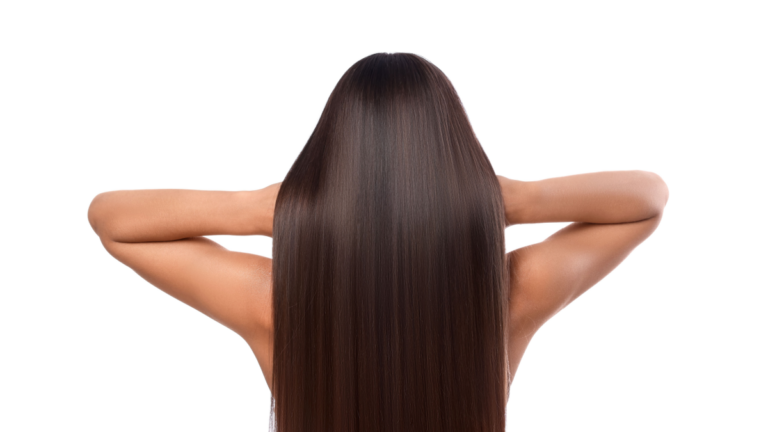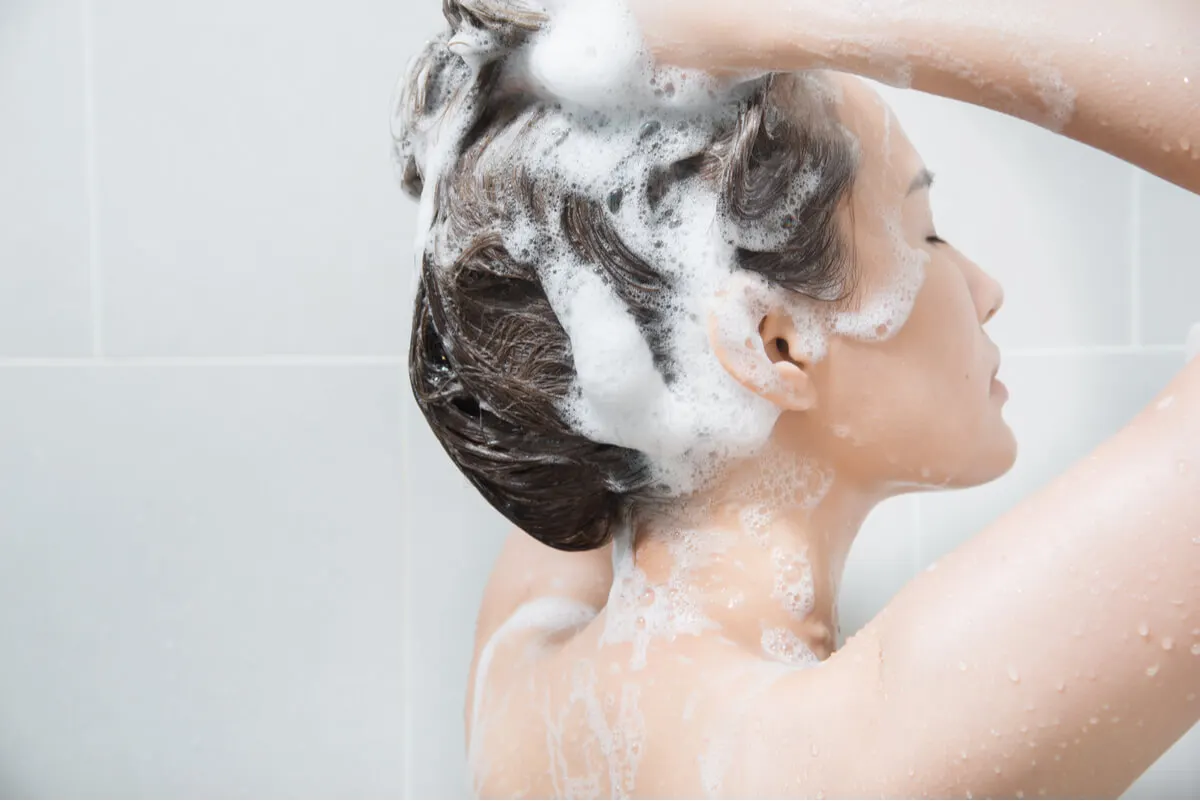What Is the Liquid Hair Effect and How Can You Achieve It?

Smoothing the hair as much as possible is the end of the liquid hair effect. This styling trend is a favorite of women who find elegance in its simplicity.
It’s not about chignons or defined waves, it’s about the lightness of straight hair that shines and looks soft, smooth, and fluid. The advantage of styling your hair the liquid way is that this look goes hand-in-hand with any outfit you choose. Short or long dresses, jeans, evening gowns, or a sporty look will suit the ultra-straight look.
You don’t need to have fine hair to get the effect. We’ll tell you everything you need to know in this article.
What is the liquid hair effect?
Liquid hair is the very straight appearance of hair, regardless of whether the natural shape is frizzy. The captivating thing about the technique is the silky, shiny look with movement. In favor of the style, the particularity to clear the face and offer an impressive frame to the look stands out.
It’s essential that your hair is healthy to enjoy this style. Otherwise, it will not show the lightness that characterizes the style.
The effect is better if you received a moisturizing treatment beforehand. There are methods to straighten your hair naturally, but they can also be chemical based.
The aim is to nourish the hair fiber so that the liquid finish is impeccable. However, it’s important to keep a few things in mind so that the straightening treatment doesn’t damage your hair.
The U.S. Food and Drug Administration (FDA) warns that hair softeners generally contain formaldehyde. This substance requires the heat of an iron to permeate. The ingredient is released into the air as a gas and, in the absence of ventilation, there’s a risk of inhaling it.
To carry out the process, as recommended by the FDA, do it with the help of a stylist. Check the composition of the material to be used and check for possible adverse reactions.

We think you may also enjoy reading this article: Smoky Gold: Check Out the Latest Hair Trend for a Younger Look
Tips for achieving the liquid hair effect
Once the hair has received the straightening treatment, for a liquid hair effect to make an impact, put the following tips into practice.
1. Use hair spray
You can find hair sprays that have the ability to straighten hair and make it more manageable. These kinds of solutions eliminate frizz and give hair a pre-base for blow-drying or flat ironing to reach the maximum softness level. Instant smoothing formulas moisturize and prepare the hair for heat.
2. Blow dry or flat iron
Straightening treatments are so efficient that, depending on how curly your hair is, you may not need to subject it to heat to straighten it. However, if you want liquid hair, you need to use thermal tools.
Straighteners, blow-dryers, or straightening brushes discipline the hair. To avoid damaging the hair, it’s essential to spray it with a heat protector beforehand. For the same purpose, flat iron only if the hair is completely dry; if you do it when it’s still wet, you “cook” the cuticle with the steam.
3. Nourish and moisturize
A well-nourished and moisturized head of hair is easy to style and handle. This benefits the liquid look. Include products in your hair care that prevent frizz and contribute to hair health.
Topics for Education magazine explains that following a balanced diet is the main basis for hair wellness. They add that trace elements, minerals, and vitamins are indispensable in the diet for this purpose.
Among the nutrients required by the hair, an article in Professional Pharmacy lists the following:
- Zinc
- Iron
- Magnesium
- Folic acid
- Vitamin B6
- Vitamin B12
- Sulfur amino acids
In addition, serums and moisturizing oils are beneficial for liquid hair, as they nourish and provide the shine and finesse that the technique seeks.
4. Create a mirror effect by parting your hair in the center
The striking thing about ultra-straight hair is that the back of the hair cascades down with impressive flexibility, while the front styling complements the make-up.
To ensure that this is always the case, create a hairstyle that favors the liquid hair effect, which is parted in the middle with a parting in the middle to create a mirror effect. The strands that remain in the front part of the hair should be worn behind the ears.
The trend allows for slight variations, such as half-curled ends.
5. Choose the right haircare products
Don’t wait for an event to come around to liquid style your hair; if you take care of it in advance, the results will be phenomenal. It’s crucial to select a shampoo and conditioner for extra straight hair.
These formulas have moisturizing and multi-smoothing properties. Similarly, anti-frizz sprays and wipes are among the alternatives that eliminate static.

6. Use a good blow-drying technique
It isn’t enough to just run the mouth of the dryer over the hair.
The secret is to use the narrowest dryer head while pointing the dryer towards the floor. This way, you prevent the ravages of high temperatures.
Like this article? You may also like to read: Get Silky Shiny Hair with this Banana and Avocado Hair Mask
How to take care of your hair after achieving a liquid hair effect
When exposed to the heat of straighteners and blow dryers, as well as professional straightening substances, your hair needs special attention to recover. Washing your hair is essential, as is spacing the cleansing according to the requirements that respond to the type of hair.
The Fundación Piel Sana suggests the consumption of vitamin complexes rich in specific elements for the hair and also recommends avoiding products that have a negative impact on the capillary fibers.
All cited sources were thoroughly reviewed by our team to ensure their quality, reliability, currency, and validity. The bibliography of this article was considered reliable and of academic or scientific accuracy.
- Cuidados estéticos para el embellecimiento capilar. Temas para la Educación. Federación de Enseñanza de CC.OO. de Andalucía. Núm. 11. España; 2010. https://www.feandalucia.ccoo.es/docu/p5sd7616.pdf
- De Hoyos Alonso C. Cuidados básicos del cabello. Fundación Piel Sana. Academia de Dermatología y Venereología. España; 2016. https://fundacionpielsana.es/pelo/cuidados-basicos-del%20cabello
- El formaldehído en productos para suavizar el cabello: lo que debe saber. Administración de Alimentos y Medicamentos. Estados Unidos; 2021. https://www.fda.gov/consumers/articulos-para-el-consumidor-en-espanol/el-formaldehido-en-productos-para-suavizar-el-cabello-lo-que-debe-saber
- Martín Aragón MT. Nutrición y salud de la piel y el cabello. Consejo farmacéutico. Farmacia Profesional. Vol. 23. Núm. 1. España; 2009. https://www.elsevier.es/es-revista-farmacia-profesional-3-articulo-nutricion-salud-piel-el-cabello–13132077
This text is provided for informational purposes only and does not replace consultation with a professional. If in doubt, consult your specialist.








